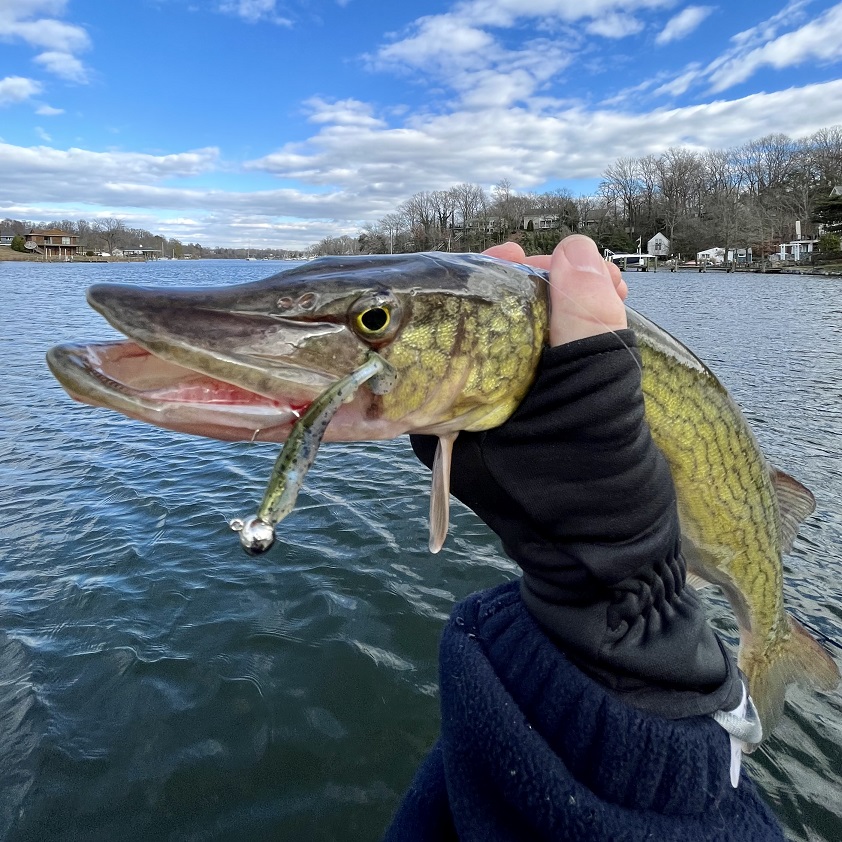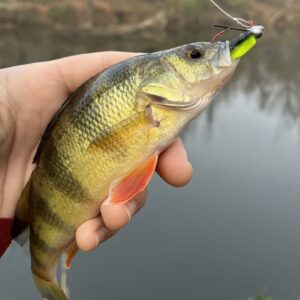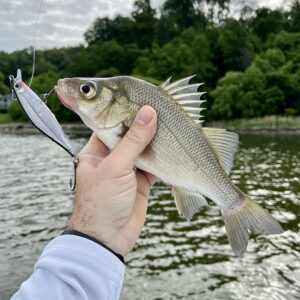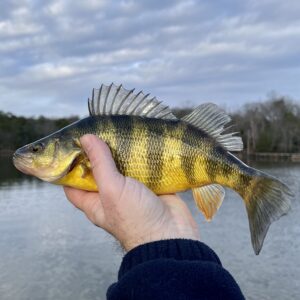Welcome to the Weekly Creel, a compilation of regional news and announcements for anglers and outdoor enthusiasts of the Chesapeake Bay region. Please email us directly at editor@reelchesapeake.com to have your organization’s news item or event listing considered for next week’s column. Per usual, here are direct links to the lastest, local fishing reports from Reel Chesapeake, On The Water, Maryland Department of Natural Resources, Anglers Sports Center, and FishTalk Magazine. The leading photograph (above): A toothy pickerel caught late-fall last year, during an outing targeting CCA Pickerel Championship-worthy entries. Photo by yours truly.
CCA’s Pickerel Championship Begins November 1st
Get your bump boards ready! Coastal Conservation Association Maryland’s acclaimed catch-photo-release tournament starring the toothy pickerel, yellow perch, and several other species kicks off on November 1st. All Maryland, D.C., and Delaware tidal and non-tidal waters are fair game to fish. The tourney is four months long, ending at 11:59 p.m. on February 29th. An awards and celebration party will be held after the tournament at a location TBD.
Sign up for the 2023–2024 CCA Maryland Pickerel Championship and catch-photo-release your way to some great trophies and other prizes. You may register any time before the tournament ends. Click here for full details.
Morgan Run Fishing Access Improved
The Maryland Department of Natural Resources (DNR) has completed significant improvements to the fly-fishing platform at Morgan Run Natural Environment Area in Carroll County to enhance accessibility for Maryland’s anglers with disabilities.
After several months of work, the area is now open and accessible for all to enjoy. Earlier this week, DNR Secretary Josh Kurtz, Maryland Department of Disabilities Assistant Secretary John Brennan, and project partners held a ribbon cutting ceremony to officially open the upgraded fishing area.
Working with the Maryland Department of Disabilities and other state and local partners, DNR upgraded the fishing platform at the Eldersburg park to make it ADA-compliant. The upgrades included reconfiguring the slope of the existing pathway, paving the parking lot, and creating a more favorable instream habitat to hold trout closer to the fishing platform. These improvements allow anglers with mobility disabilities to easily and safely access the fishing platform and provide a better fishing experience at Morgan Run. Photograph of a trout fisherman casting a line into the upgraded stream bed at the Morgan Run fishing platform. Photo by AJ Metcalf, Maryland Department of Natural Resources.
National Aquarium Building Outdoor Exhibit
The National Aquarium announce this week that work will begin next month on Harbor Wetland, a groundbreaking outdoor exhibit set to debut in Summer 2024 between Piers 3 and 4 on the Aquarium’s Inner Harbor campus. Developed over many years under the working name Waterfront Campus Plan, the project will pay homage to Baltimore’s pre-industrial history as a tidal salt marsh while furthering the Aquarium’s mission of environmental stewardship and conservation and engaging Baltimoreans and visitors with the Inner Harbor in a beautiful and functional wetland setting outside of the Aquarium’s walls.
“Harbor Wetland is a completely new idea: a habitat, exhibit, and floating public park all in one. In a beautiful, accessible space, Baltimoreans and visitors alike will gain a new appreciation of the rich biodiversity of the Chesapeake Bay,” said National Aquarium President & CEO John Racanelli. “Within the important redevelopment underway all around the Inner Harbor, our Harbor Wetland space helps set the stage for both the economic and ecological success of downtown Baltimore in the years ahead.” Rendering courtesy National Aquarium.
Maryland Gov. Moore to Lead Chesapeake Executive Council
Maryland Governor Wes Moore was elected chair by members of the Chesapeake Executive Council last week when they gathered at the National Arboretum in Washington, D.C., for their annual meeting. Governor Moore takes over leadership of the federal-state Chesapeake Bay Program partnership from U.S. Environmental Protection Agency (EPA) Administrator Michael Regan, who has led the Council for the past two years.
“I’m honored and deeply humbled to serve as the Chair of the Chesapeake Executive Council,” said Maryland Governor Wes Moore. “The Chesapeake Bay is part of who we are as Marylanders—and plays a vital role in our state’s environment and economy. Maryland is ready to take the lead on this important work, and we know we won’t be working alone. I am optimistic that if we take shared responsibility, hold each other accountable and follow the science—we can achieve our vision of a cleaner, healthier Bay for all.”
Established 40 years ago following the signing of the first Chesapeake Bay Agreement, the Chesapeake Executive Council is responsible for guiding the policy agenda and conservation and restoration goals for the Chesapeake Bay Program, a regional watershed partnership. Members include the governors of Delaware, Maryland, New York, Pennsylvania, Virginia and West Virginia, the mayor of the District of Columbia, the chair of the tri-state legislative Chesapeake Bay Commission, and the administrator of the EPA on behalf of the federal government.
At their 2022 annual meeting, the Council directed the Bay Program’s Principals’ Staff Committee with recommending a critical path forward that prioritizes and outlines the next steps for meeting the goals and outcomes of the Watershed Agreement. The result of this work was the Executive Council’s acceptance of three overarching recommendations that will be used to guide the partnership’s work until 2025.
The Chesapeake Bay Program will now focus on the second part of the 2022 charge—continuing to address new advances in science and restoration while focusing on the future of Bay restoration. Recommendations for what the partnership will look like post-2025 will be presented to the Council at their 2024 meeting. Photograph courtesy Office of Gov. Wes Moore.
Crisfield Exploring Flood Resilience Projects
The City of Crisfield is working with the Federal Emergency Management Agency (FEMA) Building Resilient Infrastructure and Communities (BRIC) Direct Technical Assistance (DTA) to develop flooding mitigation and resilience projects. BRIC DTA gives full support to communities that may not have the resources to begin climate resilience planning and project solution design on their own. The City anticipates submitting a BRIC grant for infrastructure that will mitigate flooding and is working with DTA to identify the best use of these potential funds. The DTA team members and City of Crisfield staff and elected officials have been meeting for almost a year to develop the content for this grant application.
This project is anticipated to have two phases for two different sections of town, with an application for the first phase to be submitted in January 2024. The DTA team is considering combining several possible flooding mitigation strategies including tide gates, bioretention
ponds, stormwater pumps, improvements to the stormwater drainage system, elevated roads, and berms. These new strategies will transform Crisfield landscape and greatly reduce flooding.
In the coming months the City of Crisfield will be coordinating with property owners for this beneficial transformation. There will also be opportunities for community members and property owners to have detailed conversations with staff and elected officials of the City of
Crisfield and with FEMA Building Resilient Infrastructure and Communities (BRIC) Direct Technical Assistance (DTA) staff. The City of Crisfield will send out a detailed press release and e-newsletter about this project this fall as all aspects of the project are finalized for the grant application.
AI Fishing Assistant Launched
Tackle.net recently unveiled FishGPT, its AI-powered fishing assistant. This tool offers fishing insights, simplifying pre-fishing preparations, and delivering real-time, actionable recommendations that empower fishing enthusiasts to maximize their catchy. This latest offering follows the success of Tackle.net’s AI Lure Generation tool.
Armed with a robust dataset amassed from over half a million hours of top-tier tournament footage and expert angler tutorials, FishGPT is a comprehensive compendium of fishing wisdom that leverages insights from thousands of hours of high-stakes bass tournament footage and a vast repository of authoritative fishing resources, with a specialized emphasis on bass fishing.
The system harnesses state-of-the-art AI technology from industry leaders such as OpenAI, LangChain, Vercel AI, and Supabase. This formidable yet scalable architecture enhances the capabilities of casual and competitive anglers and opens doors for seamless expansion into specialized fishing categories and diversified industry applications.
Ivan Wong, Founder and CEO of Tackle.net, enthused, “FishGPT is not just another fishing assistant; it’s a leap forward in angling technology. By applying AI, we’re able to offer data-driven, expert-level advice right at your fingertips, democratizing the sport and enhancing the angling experience for all.” Check it out at tackle.net/ai.
Our take: It’s a nifty, fun tool that offers insights, but doesn’t replace first-hand experience gained on the waters you fish.
And that’s a wrap for this week’s Creel. If you have news to share, please send an email to editor@reelchesapeake.com.









